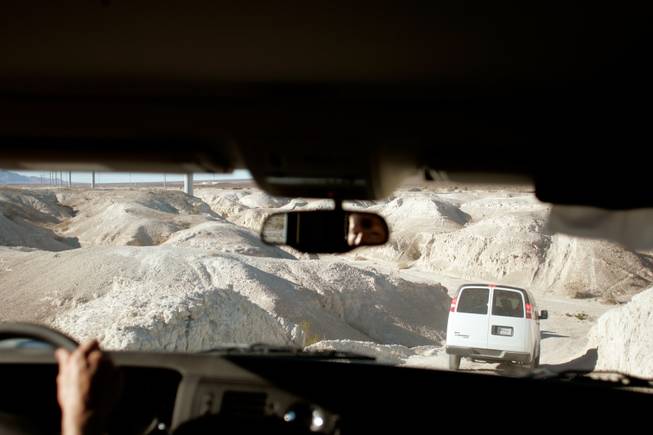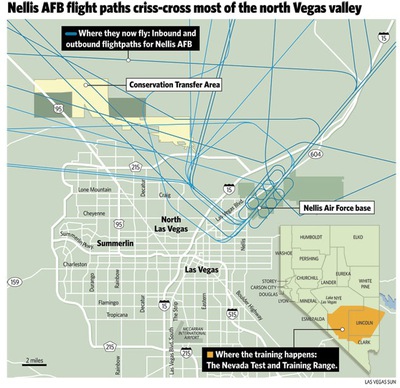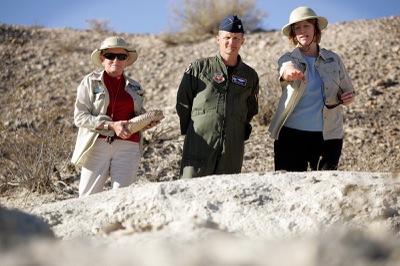
Members of the Protectors of Tule Springs drive into the Upper Las Vegas Wash area, part of the 13,000 acres the group wants to be turned into a conservation area. The Air Force backs this conservation effort because it helps ward off development near Nellis Air Force Base.
Monday, Dec. 8, 2008 | 2 a.m.
Beyond the Sun
The Las Vegas of 1941, when the Strip was still U.S. 91 and not even 10,000 people lived here, seemed a practical place to build a military base.
The notion that it would be overtaken by suburban sprawl remained far-fetched for decades.
But then the 1990s came, and no other metropolitan area in the country grew faster than the Las Vegas Valley, and it has remained among the top five fastest-growing since 2000.
And today it seems on an inexorable collision course with Nellis Air Force Base, one of the nation’s most important combat-training bases.
Nellis commander Col. Howard Belote worries that should the base lose the open space to the north that accommodates its training and combat-preparation flights, then “the reason for Nellis to exist is almost gone.”
Still, North Las Vegas is charging ahead with growth.
“The Air Force would like to see very low density, if not no density, where planes fly, but I’m not sure if that’s reasonable because we would have to stop development where we’re at and not proceed further,” Frank Fiori, director of planning and zoning for North Las Vegas, said about the city’s future.
Communities may boast of their growth, but it’s difficult to overstate the significance of Nellis.
Nellis tests and develops weapons systems and serves as something akin to a graduate school for pilots who go into combat knowing that if they can survive 10 combat missions, their chances of returning home are greatly increased. To that end, Nellis gives pilots the opportunity for those first nine training missions that are as close to combat conditions as possible. Nowhere else in the country can the Air Force — and allies from all over the world — train as they do at Nellis. Almost all the training with live ordnance happens there.
So concerned was Nellis with losing its ability to train, it opened a public policy office in May to address nearby development.
The Air Force says it needs to protect three vital assets provided by Nellis: the ability to launch aircraft, to fly over open space with live ordnance, and to use sufficient air space to conduct air-to-air combat training. (The Air Force flies over 3 million acres of government-owned desert that in many respects passes as Afghanistan.)
Before growth exploded, relations between the base and local jurisdictions were simpler when it came to development. For example, in the 1980s, when Steve Wynn wanted to build a golf course, the base said it would be fine if he’d just move it a little north or a little south.
“We’re no longer able to accommodate those kind of requests,” said Deb MacNeill, director of Nellis’ public partnership office.
Nellis has since altered its flight patterns to avoid flying low with live ordnance over the southern part of the valley. The Air Force is also hemmed in by surrounding mountain ranges — pilots can’t get high enough fast enough to make it over them. So Nellis has effectively lost a good portion of its runway patterns and is now limited to those on the north side of the base.
The base has also acquiesced to noise complaints and agreed not to fly below a certain altitude, even though each restriction degrades the training.
And now North Las Vegas is annexing large areas near the northern end of base with a master plan for major, high-density growth. About 50 projects are proposed, including casinos and shopping centers.
Clark County Commissioner Tom Collins said he is concerned North Las Vegas’ quest for an identity will run roughshod over Nellis’ needs.
It’s unlikely one development project alone would put a halt to Nellis’ mission, but as Collins put it, the base is in danger of dying a death of a thousand cuts. This has happened in other areas of the country. To the north, Naval Air Station Fallon has taken over the elite Top Gun mission because there was no more room for it in Southern California.
There is little in federal law that offers Nellis a buffer against encroachment, and the military has recognized in the past few years that it needs be more aggressive at higher levels in protecting against that issue. The Air Force has been slower than the other services to get on board.
Some members of Congress, such as Democrat Sen. Ken Salazar of Colorado, which has air bases facing similar issues as Nellis, have been pushing the Air Force to create a Pentagon-level encroachment program, identifying potential problems and budgeting for long-term solutions.
Land nearest to the fence line is a top concern. A few years ago, Congress approved $40 million for Nellis to buy more than 340 acres of such land to buffer runways from approaching development. But that isn’t a financially workable solution for the rest of the land involved, so the military has to use persuasion in dealing with the local governments that have land-use powers.
The state made fending off incompatible building a little easier for Nellis in 2007, passing a law requiring that the base be notified about impending development. Nellis has prepared a map identifying areas of high noise and accident potential, which Clark County has used to establish compatible land uses within those zones. And Nellis is working with North Las Vegas on one as well. But these agreements are limited.
Nellis and others are learning that while it is necessary to ward off development near the fence line, it also needs to monitor more distant growth proposals.
Case in point: the Bureau of Land Management, the largest landowner in Nevada — plans to auction land for development miles away that might affect Nellis.
“One element of the federal government is encouraging development and another is going ‘whoa, wait a minute,’ ” said Joseph Schilling, an assistant research professor at Virginia Tech who works with the Department of Defense on this issue.
Sen. Harry Reid, D-Nev., introduced legislation in September to build a northern UNLV campus on one such BLM parcel. Because of the potential for conflict, Nellis essentially has veto power over the proposal, but the base has so far not objected to the school’s expansion.
Development isn’t an either-or proposition — there are uses that are compatible with Nellis — but “a city, unfortunately, is not the best,” MacNeill said.
The Air Force tries to work with developers at the napkin-planning stage to prevent any incompatible development. But problems still arise. In 2006 the Air Force leaned on the Clark County Commission to quash a proposed 10-story condominium development near the Las Vegas Motor Speedway. The plan was abandoned.
Developers, residents and governments, Collins said, need to recognize that Nellis was here first — in fact it predates even El Rancho Vegas, the first casino resort built on what would become the Las Vegas Strip. Industrial uses are the most compatible with the base, but Fiori said he isn’t sure the city and Nellis can even agree on what is industrial.
The Apex Industrial Park as it stands now is compatible, but there could be conflict as the area is built up around it. There was an unsuccessful push by developers to rezone the area in 2004.
As the valley continues to grow and the military evolves, Ret. Army Brigadier Gen. Bob Barnes, military liaison for The Nature Conservancy said, “the chances increase of a clash of social values.”



Join the Discussion:
Check this out for a full explanation of our conversion to the LiveFyre commenting system and instructions on how to sign up for an account.
Full comments policy